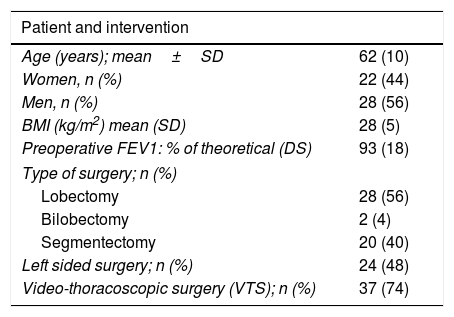Although pulse pressure variation (PPV) is an effective dynamic parameter widely used to predict the increase in cardiac output after the administration of fluids in abdominal surgery, its use in thoracic surgery is controversial. A study was designed to describe the behaviour of PPV during lung resection surgery.
Patients and methodsA prospective observational study was conducted on adult patients scheduled for lung resection surgery. Patients with bleeding greater than 200cc, or those who required vasopressors during data collection, were excluded. The PPV values were collected during different phases: in bipulmonary ventilation (T1), after the start of single lung ventilation, and the opening of the thorax (T2), at the end of the procedure prior to the restoration of the bipulmonary ventilation (T3), and after the closure of the thorax in bipulmonary ventilation (T4). The correlation coefficient of the PPV values at the different times was calculated.
ResultsThe study included 50 consecutive patients. The mean values and standard deviations of PPV in the different phases were: T1, 11.14% (6.67); T2 6.24% (3.21, T3 5.68% (3.19); and T4 7.84% (4.61). The repeated ANOVA measurements found significant differences between the mean values of PPV in the different phases (p<0.001).
The correlation between the PPV values during T1 and T2 (PPVT1 and PPVT2) was r=0.868 ([p<0.001], r2=0.753), while between T3 and T4 (PPVT3 and PPVT4) the correlation was r=0.616 ([p<0.001], r2=0.379) between the PPV values in T3 and T4.
ConclusionsPPV presents a predictable behaviour in the course of lung resection surgery, characterised by a decrease of almost half at the beginning of the unipulmonary ventilation and opening of the thorax. It then remains stable throughout the surgery when there are no changes in the intravascular blood volume.
La variación de presión de pulso (VPP) es un parámetro dinámico eficaz y ampliamente empleado para predecir el aumento del gasto cardiaco tras la administración de fluidos en cirugía abdominal, sin embargo su uso en cirugía torácica es controvertido. Se diseñó un estudio para describir el comportamiento de la VPP durante cirugía de resección pulmonar.
Pacientes y métodosEstudio observacional prospectivo en pacientes adultos programados para cirugía de resección pulmonar. Se excluyeron los pacientes con sangrado mayor de 200cc o con necesidad de vasopresores durante la recogida de datos. Se recogieron los valores de la VPP durante diferentes fases: en ventilación bipulmonar (T1), tras el inicio de la ventilación unipulmonar y la apertura del tórax (T2), al finalizar el procedimiento previo a la reinstauración de la ventilación bipulmonar (T3) y tras el cierre del tórax en ventilación bipulmonar (T4). Se calculó el coeficiente de correlación de los valores de VPP en los diferentes momentos.
ResultadosSe incluyeron 50 pacientes consecutivos. Los valores medios y desviaciones estándar de VPP en las diferentes fases fueron: T1: 11,14% (6,67); T2: 6,24% (3,21; T3: 5,68% (3,19) y T4: 7,84% (4,61). El ANOVA de medidas repetidas encontró diferencias significativas entre los valores medios de VPP en las diferentes fases (p <0,001).
La correlación entre los valores de VPP durante T1 y T2 (VPPT1 y VPPT2) fue de r = 0,868 ([p <0,001], r2 = 0,753), mientras que entre T3 y T4 (VPPT3 y VPPT4) la correlación fue de r=0,616 ([p <0,001], r2=0,379) entre los valores de VPP en T3 y T4.
ConclusionesLa VPP presenta un comportamiento predecible en el transcurso de cirugía de resección pulmonar, caracterizado por una disminución de casi el 50% al inicio de la ventilación unipulmonar y apertura del tórax y posteriormente se mantiene estable a lo largo de la cirugía cuando no hay cambios en la volemia.









